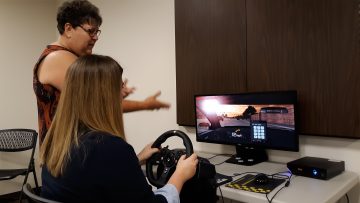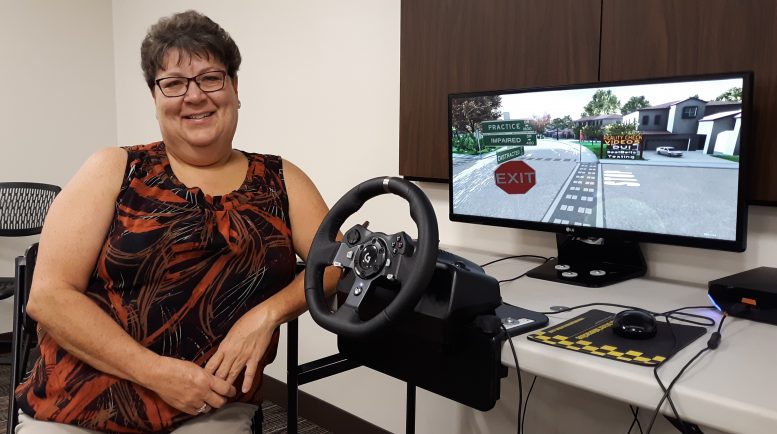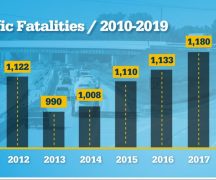By JAN LARSON McLAUGHLIN
BG Independent News
With no warning, a car strays into the neighboring lane.
“Is this not Bowling Green,” said Sandy Wiechman, Wood County Safe Communities coordinator. “You really have to pay attention.”
The driver manages to avoid a collision, but seconds later, a dog runs into the street. She slams on the brakes, but it’s too late.
“She just killed a dog,” Wiechman said.
In this instance the dog and the driver are fine, since the crash occurred on Wood County Safe Communities’ distracted driving simulator. The simulator gives drivers an idea of the distractions out on the road, without the threat of injuries.
The “driver” sits behind the steering wheel, with control of the wheel, the gas pedal and the brake. But there is much the driver has no control over.
“You’ve got distractions all over the place,” Wiechman said.

Wiechman instructs ‘driver’
There’s a soccer ball that rolls out on the street, fire trucks approaching, construction cones, sun glaring into the windshield, school buses stopping, dogs and cats dashing into the road, pedestrians and bicyclists.
And then there are the distractions inside the vehicle. There’s an annoying passenger who keeps asking the driver to make a call or text for him.
In Wood County, about 4.5 percent of car crashes are blamed on driver distraction. In 2017, drivers reported the following distractions: Cell phone, 25; texting or emailing, 5; other electronic communication device, 7; electronic devices such as navigation devices, DVD player or radio, 39; others inside the vehicle, 99; and external distractions outside the vehicle, 84.
Wiechman said the distractions go far beyond texting. Some people try eating lunch, check out the neighbor’s yard, or look to see if they know the bicyclist as they pass.
“I refuse to do it just on texting. There are just so many things that can happen,” she said.
“You never know when a kid is going to dart out into traffic,” Wiechman said. “One time can ruin your life and someone else’s life.”
Even conversation in the car can be distracting.
“You just have to pay 100 percent attention,” she said.
It isn’t long before the “driver” is cut off by another car, swerves to avoid that vehicle and then hits an oncoming vehicle head-on. The simulator screen then gives the driver a view of the EMS crew standing over as an air ambulance lands nearby.
The driving simulator is more important now, Wiechman said, since schools no long offer drivers education, and most students take driving classes online.
“They think they are more in control than they really are,” she said.
The simulator can also be used to show drivers the challenges of operating a vehicle under the influence of alcohol or drugs.
“It simulates drunk for you,” Wiechman said.
After the motorist crosses into oncoming traffic, a police officer pulls the car over and asks for a driver’s license. Upon smelling alcohol in the car, the officer then asks the driver to exit the vehicle to do a field sobriety test.

The driving simulator was purchased in 2017 with donations from the Bowling Green Dancing with the Stars event and from the Rossford Police Department.
“We’ve been using it non-stop since,” Wiechman said. “This is just invaluable to me.”
The simulator is usually used with students ages 14 and older. Before they take the wheel, they get some education from Wiechman and a police officer.
“We really don’t want it to be just a fun tool,” she said. “It’s not just something to giggle at.”
In addition to using the simulator in schools, some local industries also ask Wiechman to let employees who will be operating forklifts or other vehicles to try the simulator. Some senior citizen programs also like to make it available to older adults.




